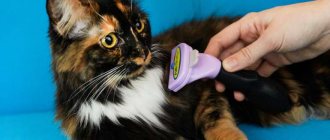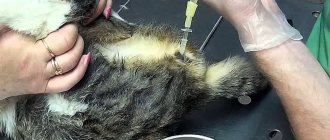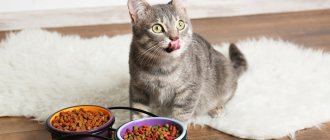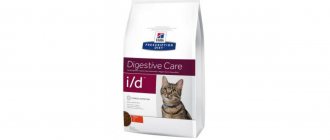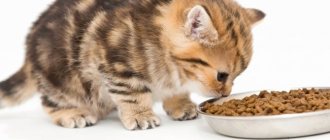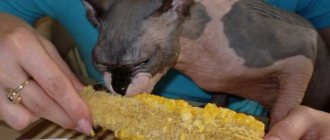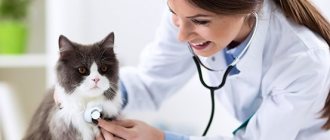To keep your cat healthy and live long, it is extremely important to provide her with proper nutrition. Owners often give the animal the food that they themselves eat. Veterinarians categorically do not recommend doing this. Natural food for a cat is not food from the owners’ table. An unbalanced diet can cause serious harm to an animal's health. According to the type of metabolism and physiology, cats are carnivores. Their diet during evolution included animal fats and proteins, so modern domestic cats have certain nutritional needs.
In this article I will tell you what to feed your cat, how to organize its proper nutrition and what is best to choose.
Proper nutrition for cats
Every cat needs a systematic intake of the following substances into its body:
- Arginine. This amino acid is present in animal proteins.
- Taurina. This is an acid, the lack of which leads to disturbances in the functioning of the cardiovascular and nervous systems, and reduces the reproductive capacity of animals. Taurine is present in beef and fish (most of all it is found in cod).
- Arachidonic acid. This substance is found in animal fats.
- Fatty acids (saturated and unsaturated). Fats are a source of energy. Their lack in the diet negatively affects the coat of the pet, which takes on a greasy, unkempt appearance.
Some owners mistakenly believe that cats can only be fed meat or fish. This is not true. It is very important that the animal’s diet is varied. Wild cats eat birds and small rodents, eating their prey along with the contents of its stomach - grass and grains.
The cat's diet should include the following types of foods:
- fish, meat, seafood, liver;
- eggs;
- dairy products;
- cereals;
- vegetables, greens;
- oils and fats.
When giving food to your cat, make sure that the food is not too cold or hot. For normal digestion, cat food must be at a neutral temperature.
What to feed your cat
The recommended daily allowance for a cat is three meals a day in a certain quantity. The calculation depends on age, physical condition, gender, as well as breed. For example, an adult cat weighing about 5 kg will need 150-200 g of homemade food, 60 g of dry food or 300 g of wet food.
If you are worried that your pet is not eating enough, think about what will happen if she starts to overeat. Obesity is very dangerous for cats, so take care of your pet and do not overfeed him.
What to feed your cat - expert advice
Read about the Siberian cat breed here.
Cats do not have enzymes in their bodies to digest fiber. So do not give her foods such as pasta, bread, etc., otherwise in five to seven years she will suffer from gastrointestinal disease. You don't want to doom your pet to this, do you?
List of foods to feed cats:
- fish about once a week. Give boiled, pitted;
- Give meat (except pork) raw in small pieces. You can also scald the meat with boiling water;
- kefir, fermented baked milk, curdled milk, cottage cheese, milk is desirable only for kittens (adult cats do not digest lactose, so milk becomes useless for them and causes digestive upset);
- cereals;
- vegetables (zucchini, corn, carrots, peas, etc.) in any form;
- sprouted grass;
- any soups.
Water is the most important thing for a cat. It should always be clean and constantly accessible to the cat.
Pets need vitamins from time to time. You can find them in any pet store, mostly in tablets.
List of foods that are prohibited for cats:
- fried, spicy, fatty foods;
- sausages, sausages;
- tubular bones (you can give soft bones, for example, chicken ribs);
- canned food (sprats, stewed meat, etc.);
- mayonnaise.
It is also not advisable for a cat to eat ready-made food. Even the best and most expensive ones. Eating ready-made food, she does not receive the necessary vitamins and nutrients, no matter how the manufacturers promise.
The best food is natural. But if it is still not possible to feed your pet homemade food, then try to carefully choose food for your cat. The main thing is that your pet is healthy and happy. Let's talk about this in more detail.
Features of digestion
The domestic cat very rarely gets its own food, and, nevertheless, by nature it remains a predator. This is evidenced not only by the habits of the hunter, but also by the structural features of the teeth, designed for capturing and tearing raw meat. Cats lack the molar chewing teeth that omnivores have.
Cats eat calmly and measuredly, carefully sorting and chewing their food. Even in almost homogeneous food, they will definitely find something they don’t like. These features have given the animals a reputation as capricious and picky eaters. Therefore, cat food, both at home and in industry, is made from higher quality ingredients than, say, for dogs. In addition, cats prefer warm food. This is due to their carnivorous nature. In nature, these predators eat only fresh meat. Smell and taste are of great importance to cats.
Conservative in food and habits, they are reluctant to try new foods.
And to attract the attention of gourmets, the industry adds special flavoring components. Cats are indifferent to sweets because they simply do not distinguish this taste. A very important point in the attractiveness of cat food is its moisture content, consistency, hardness and size of the ingredients.
Which artificial food is better?
Cat food can be artificial or natural. It is impossible to feed an animal both natural food and dry food at the same time, otherwise, due to poor absorption of food, it may develop pathologies such as chronic disorders of the digestive system, gastroenteritis or hypovitaminosis. This happens due to the difference in the digestion of natural products and dry food.
Feeding pets with dry and canned food is most convenient, which is why it is preferred among modern breeders. These foods do not require cooking. They contain all the minerals and trace elements that pets need.
Which artificial food is better - dry or canned? Both of these options have their own advantages and disadvantages. Wet food is eighty-five percent water. They are classified as perishable products, so they can be stored open for only a few days. Dry food is much more convenient to store and use, which is why many breeders prefer them.
Dry cat food
Ready-made cat food is divided into 3 classes - economy class, middle class, and premium class. Veterinarians claim that widely advertised economy-class food has a number of significant disadvantages. Manufacturers make them from cheap raw materials (offal, bones, feathers, leather) and add many chemical flavorings and dyes to their composition.
Foods in this category differ from each other only in their tastes. Constantly feeding an animal with economy-class food can cause kidney disease or urolithiasis. Middle-class ready-made food contains fewer dyes and flavoring additives.
For their production, higher quality raw materials are used, although they are also based on by-products. Premium and super-premium food are the most beneficial for animals.
What to do?
If the cat asks to eat more than the norm, then you can:
- change the food to a more expensive and nutritious one. Cheap economy class mixtures do not contain the vitamins, minerals, and biologically active substances necessary for normal growth and development of the animal. Their deficiency in the cat’s body provokes overeating;
- do not feed in excess of the norm, focusing on the instructions for consuming food, the age and physiological characteristics of the cat;
- organize fractional feeding at the same time - 2-3 times a day;
- eliminate unscheduled snacks that are skillfully begged for by cunning manipulative cats.
A pregnant cat must be fed with specially formulated food that contains the full range of essential nutritional components or the diet must be further enriched with vitamins and minerals. As a preventive measure and to get rid of parasites, regularly administer anthelmintic drugs.
Diabetes mellitus and intestinal diseases require diagnosis and drug treatment. You should also contact a veterinarian if, despite all efforts, the cat constantly asks for food, and its appearance leaves much to be desired.
The benefits of feeding animals natural products
Natural food is most beneficial for pets, since when using it, the owner can select an individual diet for his pet, taking into account the characteristics of his body. A well-chosen ratio of vitamins, fiber and macronutrients allows you to provide your pet with everything it needs for a full life.
Natural food is fresh food that does not contain additives or preservatives found in dry food.
If you decide to feed your cat natural food, keep in mind that such food must be varied. An animal should be accustomed to various foods at an early age. Never give your pet food from your own table - dishes eaten by people are not suitable for cats, some of them can cause severe indigestion in the animal. In addition, by feeding your cat from the table, you develop the habit of begging in it.
Under no circumstances should you feed your cat spicy or salty food or give it any smoked foods. You should not give her any bones, especially chicken bones, which can injure the animal’s internal organs as they pass through its digestive tract.
What should you not feed your cat?
- sweet;
- fried;
- pickled and salted;
- flour and baked;
- food containing seasonings and spices.
Do not forget that in order to empty the stomach of the accumulated hair in it, the cat needs to eat grass regularly. You can grow it at home in flower pots or purchase it at a pet store. The kitten must have its own dishes and a permanent place to eat.
If you feed your cat natural products, do not forget about mineral supplements and vitamins that must be periodically added to his food.
The basis of a cat's diet should be meat. Experts recommend feeding cats the following foods:
- veal and beef;
- turkey and chicken;
- rabbit meat;
- meat puree for children;
- lean sea fish.
Vegetables are also good for cats, but not all animals like them. Mix chopped vegetables into the meat products you give to your cat, then the animal will not even notice their presence in its diet. The most beneficial vegetables for cats are: beets, carrots, lettuce, cauliflower, pumpkin, zucchini. Eggplants and tomatoes should not be given to cats - they contain substances that are harmful to the cat's body.
Offal is given to cats a couple of times a week, not more often. The liver, for example, contains a lot of vitamins, protein, carbohydrates, but very little calcium. If you give an animal a lot of liver, its body may have an excess of vitamin A and a lack of calcium. This can cause brittle bones in adult cats and improper skeletal formation in kittens.
When organizing feeding a cat, you must follow the following rules:
- Cats need amino acids, so they need to get enough meat products every day. The more quality animal protein your cat has in her diet, the more strength and energy she will have.
- Contrary to popular belief, many adult cats refuse to drink milk. Some of them even experience indigestion from eating dairy products.
- A couple of times a week, your pet should be fed chicken eggs, liver and a small amount of porridge. This will provide the animal’s body with B vitamins.
- Cats like fish, but this product is not necessary for them. They need the taurine found in fish, which is also found in meat. Therefore, you can completely replace fish products with meat products in your animal’s diet. At the same time, remember that neither fish nor meat should be given to animals raw in order to avoid infecting them with parasites.
- Your cat should be given food twice or thrice a day. The animal must have access to water at all times.
- The nutrition of an animal directly depends on its physical condition. During pregnancy, as well as feeding kittens, it is very important that the cat’s diet is balanced in calcium and protein. Spayed and neutered animals should eat fewer calories to avoid becoming overweight.
Features of feeding kittens
Depending on their age, kittens are fed differently. Each baby has its own diet, its own characteristics.
Newborns
How to feed newborn kittens? From the moment of birth, the cat takes full responsibility for its offspring. With mother's milk, kittens get everything they need. Your task is only to observe the process, provide the mother with clean water and quality food, periodically change the bedding and make sure that the kittens gain weight of at least 100 grams per week.
It happens that young cats refuse kittens, their milk is not enough or it does not meet all the requirements, the kittens lag behind in development and need to be supplemented. To do this, thoroughly beat a liter of low-fat milk with one chicken egg, and heat this mixture to a temperature of 37˚C. It is important not to overheat, otherwise the egg white will curdle. You can also use ready-made mixtures that are sold in pet stores. The mixture is diluted with warm, boiled water; it is important to observe the temperature indicated on the package. Be sure to keep a short interval between feedings, about 3-4 hours.
Kittens are 1 month old
Upon reaching this age, kittens have already begun to walk, get acquainted with the world and will definitely show interest in their mother’s bowl; it is very important not to let them near what the cat eats. In replacement, you can offer oatmeal or rice porridge cooked in milk.
To increase the energy value, cream or a chicken egg is added to the porridge. After a week, you can introduce lean meat and fish. Manufacturers of ready-made cat food are not lagging behind here, and offer complete diets for kittens. If all is well and the food does not cause any distress, you can safely remove the kittens and transfer them to a complete natural or ready-made diet.
Kittens from 2 months
At the age of 7-8 weeks, the kitten should gain 600-800 grams, much, in this case, depends on the breed, heredity, kittens weigh a little less than cats. Gradually reduce the number of feedings per day. Now it should be about 5-6 times. Sometimes they provide unlimited access to the bowl, since at this age kittens are not inclined to overeat.
Features of feeding adult animals
Features of a healthy diet for adult cats - what are they? An adult animal should receive about 200 grams of feed per day. The basis of the diet should be meat, fish or, in extreme cases, offal, a total of 60-70%. The remaining 30-40% is cereals and eggs, vegetables and dairy products. If there is no dry food in your animal’s diet, try to monitor the condition of the cat’s teeth. Soft foods do not help cleanse tooth enamel and it is very important to detect the onset of tartar development in time. If necessary, you need to do ultrasonic or, if there is no device, mechanical cleaning in the clinic.
The diet of castrated animals also requires special attention. If the animal gains excess weight, then its daily portion is reduced by 15-25%.
Dry food or natural products?
Every owner who gets a cat first of all has the question of what to feed it? It’s one thing when a pet is not picky about food and eats literally everything that is given to it, and another thing when you need to monitor the cat’s diet and feed it only what is healthy and necessary for it.
Moreover, some foods from the common table are simply prohibited to be given to cats, because the animals’ bodies are not adapted to some foods that we consider acceptable for us.
When choosing a diet for a cat, there is usually a choice between dry food and natural products. So what should you choose? First of all, I would like to note that you need to specifically choose what is best for your pet to eat.
Cats can eat either only food or natural products. Giving a little of everything is highly discouraged!
If you have enough time and spend most of the day at home, and most importantly, you have a desire to stand at the stove for the sake of your pet, then perhaps you should choose natural food. However, the state of your wallet also affects the choice of natural food.
You need to feed high-quality products: meat, fish, eggs, cottage cheese, sour cream and vegetables. And this, by the way, is not cheap. If you cannot afford to waste a lot of time and money preparing goodies for your cat, you should opt for food.
But even when choosing food, everything turns out to be not as simple as you might think. Do not choose economy class food for your pet. In any case, you will have to overpay if you want your pet to live happily ever after. In addition, some foods are not recommended to be given at all.
Such foods are often advertised on TV, and often even experienced breeders recommend them to unknowing people. But is it worth believing them, especially if you can say anything for money?
When feeding your cat dry food, you need to make sure that she always has fresh and clean water. Moreover, access to water must be constant, because she will have to drink a lot.
When transitioning your cat to food, make sure you buy the right type of food for him. For sterilized cats, you need special food intended directly for sterilized cats. Neutered cats also need food designed for castrated cats, and so on. This instruction should not be ignored.
Canned food for cats in lamister
Canned food can be a tasty and healthy treat, which is sometimes also part of a mixed diet for cats. They have a rich composition that includes vitamins and also come with antioxidants.
Due to the variety of forms of preparation of canned food for cats (cat mousse, cat pate, minced meat, kibble, sausage and frozen food), a variety of packaging options have appeared that are most suitable for a variety of canned food forms.
Now we will talk about canned food in lamister. A lamister is a metallized container with a soft lid made of a similar material. This packaging is opened in the same way as a pate or curd dessert. In most cases, lamisters sell pates and mousses for cats.
All food, if we take the expanded classification, are divided into 5 categories: human grade, super premium, premium, medium and economy class, this depends on the quality of the raw materials and many other aspects.
When buying canned food for cats, you should take into account the age of your pet, that is, for kittens - small granules, for the elderly - low-calorie food, because it is so important to protect the health of the pet in the most demanding age categories. There are also special veterinary foods that must be given to your pet for certain diseases, so as not to harm the animal.
Main mistakes when choosing a diet
One way or another, each owner chooses what he will feed his pet, but how to feed cats and cats correctly, what to focus on when choosing a diet?
The Internet, advice from friends, advertising are not the most reliable sources, and here you can fall into some kind of “traps”. For example, there is a popular misconception that the most cat-like food is fish. Yes, many cats love fish very much, but this product should not be abused, especially if the cat has a tendency to urolithiasis. Often, owners are guided by the tastes of the cat itself, without delving into the essence of the issue; such indulgence of the pet’s preferences can lead to serious consequences. Information from the manufacturer, when it comes to ready-made food, is partly of an advertising nature - this is the law of the market, so you should not blindly trust advertising either. You can contact a specialist, but when it comes to feeding a cat correctly, a veterinarian’s advice may not always be a panacea.
Firstly, there are not many veterinary nutritionists in Russia, and they cannot be found in every city. And sometimes even the most experienced veterinarian, who can operate on a cat with his eyes closed, will not be able to give complete advice on how to feed this cat. Secondly, veterinarians often collaborate with manufacturers and recommend their ready-made food because they receive financial benefits from it, and not at all because this particular product is suitable for the pet.
So, in order to approach feeding a pet responsibly, we must have an understanding of the cat’s digestion and physiology, and also learn to understand the composition, pros and cons of different types of food.
Foods that should not be given to cats
We often decide that products that are harmless to us will remain equally harmless to our pet. It’s not uncommon for us to treat our pets to food from the common table that, it would seem, cannot cause them any harm. But don’t rush to conclusions, even the most harmless products at first glance can cause irreparable harm to your pet.
Raisin
Never let your cat near grapes or raisins. These tasty and healthy foods for humans can cause great harm to your pet. The fact is that in a cat, raisins can cause almost instantaneous kidney failure.
It happens, of course, that they themselves steal some raisins from you or feast on grapes. If you notice this, be sure to watch your cat and, if you notice any strange behavior in its behavior, grab your pet and take it to the veterinarian. Symptoms can usually be noticed within the first 24 hours. This is usually weakness, loss of appetite, and decreased urination.
Onion
Onions are one of the most dangerous foods that should not be given to pets. Onion is a slow poison that destroys the red blood cells in the cat's body and causes anemia.
But don’t rush to think that your onion consumption is limited only to rings chopped into salads or stews. No, onions are a very insidious product that is added to semi-finished products, ready-made minced meat, spice bags and even baby food. Before treating your pet to anything from this list, read the ingredients.
Garlic
Garlic is much more dangerous than onions because it contains all the same substances, but in larger quantities. Fortunately, garlic is added to a limited number of foods, but you shouldn’t forget about it.
Alcohol and tobacco smoke
Alcohol and tobacco are inherently harmful not only to animals, but also to people. Many owners watch with affection the cat's reaction when their pet drinks a little beer or wine.
In general, tobacco and alcohol cause the same harm to them as to humans. But take into account their size! For cats, these products are ten times more harmful.
Bones
Never offer your pet chicken, fish or pork bones. During culinary processing, such products can cause internal injuries to the animal, which will have a bad effect on its well-being.
Milk and cream
There is a common belief that cream and milk are cat's favorite foods. Not at all, they can only be considered favorites among kittens, but not among adult animals. Adult animals are often lactose intolerant, which leads to dehydration.
Reasons for refusing water
Despite the fact that the life of warm-blooded animals is impossible without water, furry pets consume liquid in limited quantities.
Cats are light drinkers
Table 2. Reasons why a cat neglects water
| Provoking factor | Description |
| Wet food | Spiders reduce the need to drink. |
| Mouse Hunt | If a cat eats caught mice, the need for drinking water is significantly reduced. |
| Replacing water with other sources of fluid | Frequent consumption of milk and broth can discourage your cat from drinking water. |
| Development of diseases | One of the most dangerous diseases leading to hydrophobia is rabies. In addition, the feeling of thirst is affected by urolithiasis, decreased protective functions of the body, internal damage, and pathological conditions of the oral cavity. |
| Season | In late autumn and winter, the animal's need to absorb fluid decreases. |
| Dirty dishes | Since furry pets love cleanliness, they do not drink from unwashed containers. |
Loss of appetite in cats is more common than refusal of water.
Milk and other liquids do not replace water
Recommendations and advice on feeding sterilized cats
After sterilization, the cat’s lifestyle changes: he is no longer interested in cats, and all his attention switches to food. In many cases, a problem such as obesity arises some time after surgery.
Most owners constantly give something tasty to their pet, feeling sorry for it. At the same time, many simply do not know that their metabolism is slowing down, and their diet also needs to be changed accordingly. As a result, weight increases and various diseases appear. For the longevity and health of your pet, you need to follow some rules.
The main thing is not to overfeed the animal. It is very important to play with it for much longer. In most cases, the pet will begin to additionally beg food from other people (both family members and guests). Therefore, it is worth warning them and telling them about the great dangers of such snacks.
If these recommendations are followed, but the cat continues to gain weight, it is necessary to give him a weekly fasting day. It is also important to divide the daily diet into 4-5 parts and give them to your pet throughout the day, so he will be less likely to beg for more. Since he sleeps longer after sterilization, choose fun and entertaining games for him.
There should be a sufficient amount of water in the bowl at all times. Although after surgery a cat needs to drink often and a lot, neutered animals may not understand this, drink less and, as a result, go to the toilet less.
Over time, especially with the transfer to specialized dry food, the pet will begin to drink more. If this does not happen, you may need to consult your veterinarian about diuretics.
The content of calcium, magnesium and phosphorus should be reduced in the composition of pet food. An excess of these substances leads to damage to the genitourinary system and the formation of kidney stones. Such substances are found mainly in fish and dairy products - they must be completely excluded from the animal’s diet.
Often, some time after castration, animals may refuse to eat. This happens due to problems with teeth and gums. Therefore, you need to give your cat treats that massage the gums and maintain healthy teeth. It is imperative to give preventive medications against worms and special vitamins.
The most important thing is that due to changes in metabolism and other hormonal processes, the daily portion of food for your pet should be less than in the preoperative period!
Every owner or housewife wants to make the life of their pet as pleasant as possible and create conditions for their comfortable stay in the house. An integral part of caring for pets is feeding; cats must have a balanced diet and therefore you need to choose food carefully and carefully.
Why does a cat eat a lot and not get enough?
Return to Care and feeding This forum is currently viewed by: no registered users and guests: 0
Consult with experts and choose food suitable for your cat.
Itching and parasites
The cat licks areas of the body where it is itchy or painful. Licking in the anal area can be caused by constipation. Sick areas are licked more “targeted” than itchy areas. In case of itching, the licking area exceeds the size of the itchy area. The appearance of bald patches provides clues to the cause of excessive licking of fur.
Skin wounds
Cats lick scratches and other skin lesions. This is a normal process that cleanses the wound. In nature, a cat has no other way to take care of itself. However, this may be undesirable when the wound is treated with some kind of ointment or a suture is applied. To prevent unnecessary licking, you should limit your cat's access to the affected area.
Cats really don’t like closed doors, where they used to go freely. The cat is worried, not knowing what is happening in the closed (its!) territory. Additionally, while cats can get by with a small living space, it shouldn't be too small. Perhaps any of us would begin to tear our hair out, being locked in an apartment for years 24 x 7. We consult with family members when making any decisions. And although we cannot consult with a cat, we are quite capable of taking its interests into account.
Excessive licking is not always associated with a cat's physical health. Its cause may also have a psychological basis. Cats like their lives to be predictable and orderly, so unexpected changes can be stressful, says Dr. Perry. Reconstruction of the apartment, the appearance or disappearance of other animals, and sometimes even a change in regime cause anxiety in cats.
It happens that people try to force a cat to live by their own rules and do what they see fit. Such tricks do not work with cats - she is a free animal (conditionally domestic), she cannot be defeated, you can only come to an agreement. It is necessary to take into account her interests, creating as many opportunities for the cat as possible to satisfy her natural needs.
Licking in such cases is considered “replacement behavior” (people in such cases behave similarly, for example, biting their nails) - it calms the cat, but at the same time can become habitual if the source of anxiety is not noticed and eliminated in time.
If all medical problems are resolved, then treatment for excessive licking as a result of some form of stress in the cat's life is necessary, says Dr. Perry. If possible, changes should occur gradually, while maintaining elements of the environment familiar to the cat. For example, when moving, you need to take the cat house with you.
We suggest you read: How to treat a cat with herpes on his lip. Herpes is the main respiratory disease of cats
Provide elevated platforms that cats love - they make the cat feel safe and are perceived as possible escape routes. Help your cat show its hunting instincts by playing with it for just 10-15 minutes a day. Most cats love to be played with.
In addition, licking gives cats some pleasure. Thus, excessive licking can become a habit that continues after the cause is identified and addressed. Typically, a cat's fur licking returns to normal (on its own or after assistance) within a month.
With both physiological and mental causes of licking problems, resolving them takes time and patience. With proper attention and care, the cat's fur is restored and life returns to normal.
What to feed a cat
Cats living in the wild drink very little or not at all. By eating its prey, a wild cat receives the amount of moisture it needs along with the food. A domestic cat that eats exclusively dry food must have constant access to water - otherwise it may develop kidney problems. The cat should be given boiled or filtered water to drink.
By following the rules of rational feeding of your cat, you can avoid problems with its digestion; prevent the development of diseases caused by poor nutrition; improve your pet's quality of life.
Features of feeding after childbirth
All owners who are waiting for kittens to appear in the house need to know the features of a healthy diet for cats after birth.
When you see that the cat is preparing for childbirth, looking for a place for itself, perhaps not leaving your side, limit it in food, although, most likely, it itself will not ask for anything. Place clean drinking water near the prepared area. After giving birth, the cat may not show interest in food; an appetite usually appears after 12-24 hours. They increase the nutritional value of the diet depending on the number of kittens in the litter. Nutritional value for all indicators is increased at the rate of 1% per kitten. It is better to give preference to liquid food, it will stimulate milk production. There is no need to limit access to food; the mother cat already has less free time for food.
